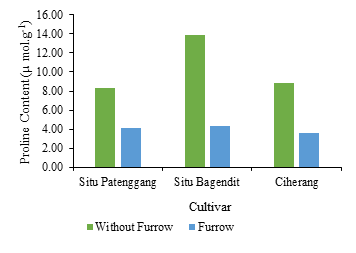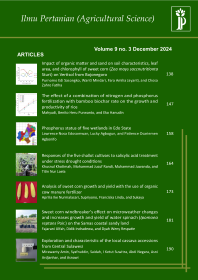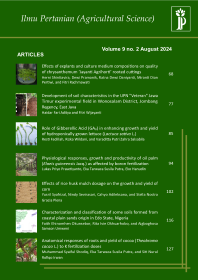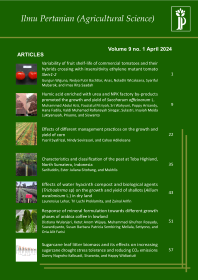
The Effect of Furrow Containing Organic Matters to Upland Rice (Oryza sativa L.) Growth and Yield in Agroforestry System with Kayu Putih
Puji Lestari Tarigan(1*), Tohari Tohari(2), Priyono Suryanto(3)
(1) Faculty of Agriculture Universitas Gadjah Mada, Yogyakarta
(2) Faculty of Agriculture Universitas Gadjah Mada, Yogyakarta
(3) Faculty of Forestry Universitas Gadjah Mada, Yogyakarta
(*) Corresponding Author
Abstract
This research was aimed to know the effects of the furrow system containing organic matter for rainfed, to growth and yield of several varieties on agroforestry system with Kayu Putih. The research was conducted in Petak 83 Resort Pengelolaan Hutan (RPH) Menggoran, Bagian Daerah Hutan (BDH) Playen, Kesatuan Pengelolaan Hutan (KPH) Yogyakarta from March to August of 2018. The experimental design applied the strip plot design. The vertical factor was the furrow system of treatment consisting of 2 levels i.e, without furrow + without organic matter and furrow + organic matters. The horizontal factors were the varieties of upland rice consisting of 3 varieties i.e. Situ Patenggang, Situ Bagendit, and Ciherang. Then the collected data were analyzed by analysis of variance (Anova) applying a level of significance α = 5%. Whenever the significant differences among treatments were found, further analysis was carried out by applying the Tukey's HSD (Honestly Significant Difference) at 5% levels. The result showed that furrow containing organic matter was able to support plant growth in dry land. Situ Patenggang has highest adaptation to growth dan produce in drought stress. The combination of furrow containing organic matter with Situ Patenggang showed the best result in CGR, total root length, total chlorophyll content, number of panicle, number of spikelet per panicle, 1000 grain weight and estimated productivity.
Keywords
Full Text:
PDFReferences
Afrianingsih, S., Untung Susanto, and Noer Rahmi Ardiarini. 2018. Toleransi genotipe padi (Oryza sativa L.) pada fase vegetatif dan fase generatif terhadap cekaman kekeringan. J. Prod. Tan., 6:355–63.
Ai, N, S and Y. Banyo. 2011. Konsentrasi klorofil daun sebagai indikator kekurangan air pada tanaman. J. Ilm. Sains, 11:166–73.
Arsyad, S. 2000. Konservasi tanah dan air. Bogor: Penerbit IPB.
Balai Besar Penelitian Tanaman Padi. 2007. Deskripsi varietas padi. Jakarta: Badan Penelitian dan Pengembangan Pertanian.
Basyir, A., Punarto, Suyanto, and Supriyatin. 1995. Padi gogo. Malang: Balai Penelitian Tanah.
Bray, E. A. 2001. Plant response to water-deficit stress. Chicago: Encyclopedia of Life Sciences.
Ezward, C., S. Efendi, and J. Makmun. 2011. Pengaruh frekuensi irigasi terhadap pertumbuhan dan hasil padi (Oryza sativa L.). J. Agro. Univ. Andalas 1:17–24.
FAO. 1989. Forestry and food security. FAO Forestry Paper 90. http://www.fao.org/3/T0178E/T0178E00.html/.
Felania, C. 2017. Pengaruh ketersediaan air terhadap pertumbuhan kacang hijau (Phaceolus radiatus), p. 131–38. In: Seminar Nasional Pendidikan Biologi. Yogyakarta: Jurusan Pendidikan Biologi, Fakultas MIPA, Universitas Negeri Yogyakarta.
Fuadi, N. A., M. Y. J. Purwanto, and S. D. Tarigan. 2016. Kajian kebutuhan air dan produktivitas air padi sawah dengan sistem pemberian air secara SRI dan konvensional menggunakan irigasi pipa. J. Irig., 11:23–32.
Hafif, B. 2016. Optimasi potensi lahan kering untuk pencapaian target peningkatan produksi padi satu juta ton di provinsi Lampung. J. Litbang Pert., 35:81–88.
Hendriyani, I. S.; Setiari, N. 2009. Kandungan klorofil dan pertumbuhan kacang panjang (Vigna sinensis) pada tingkat penyediaan air yang berbeda. J. Sains and Math., 17:145–50.
Sujinah; Jamil, A. 2016. Mekanisme respon tanaman padi terhadap cekaman kekeringan dan varietas toleran. J. Ilmu Peng. Tek. Tan. Pang., 11:1–8.
Kementrian Pertanian. 2016. Data lima tahun terakhir. http://www.pertanian.go.id/home/?show=page&act=view&id=61.
Kramer, P. J. 1969. Plant and soil water relationships: Modern synthesis. New York: Mc. Graw–Hill, Inc.
Lestari, T. 2009. Dampak konversi lahan pertanian bagi taraf hidup petani. Skripsi. Bogor: Institut Pertanian Bogor.
Liu, F., Jensen and M. N. Andersen. 2003. Drought stress effect on carbohydrate in soybean leaves and pods during early reproductive development: Its implication in altering pod set. J. Field Crop Res., 86:1–13.
Lubis, E., Z. Harahap, Suwarno, M. Diredja and H. Siregar. 2013. Perbaikan varietas padi gogo untuk wilayah perhutanan beriklim kering. p. 1-13. In: Risalah hasil penelitian tanaman pangan. Bogor: Balai Besar Biogen.
Mitra, J. 2001. Genetics and genetic improvement of drought resistance in crop. J. Plants Curr. Scie. 80: 758–63.
Mohanan, K.V. and C. B. Mini. 2008. Relative contribution of rice tillers of different status towards yield. J. Plant Breed. Gen., 2:9–12.
Ningrum, D. K. 2014. Pengaruh kekeringan terhadap produktivitas padi varietas Ciherang, Inpari 10 dan Inpari 13. Skripsi. Institut Pertanian Bogor. Bogor.
Novenda I. L and S. A. Nugroho. 2016. Analisis kandungan prolin tanaman kangkung (Ipomoea reptana Poir), bayam (Amaranthus spinosus), dan ketimun (Cucumis sativus L.). J. Panc., 5: 223–34.
Sitinjak, H. and Idwar. Respon berbagai varietas padi sawah (Oryza sativa L.) yang ditanam dengan pendekatan teknik budidaya jajar legowo dan sistem tegel. J. Onl. Mah. Fap., 2:1–15.
Slatyer, R. 1967. Plant water relationships. New York: Academic Press.
Turner, N. C. and M. M. Jones. 1980. Turgor maintenance by osmotic adjustment: A review and evaluation, p. 87–103. In: Adaptation of plant to water and high temperature. New York: John Wiley and Sons.
Yoshida, N., Dorta M. L., Ferreira A. T., Oshiro M. E., Mortara R. A., and Acosta-Serrano A. 1997. Removal of sialic acid from mucin-like surface molecules of Trypanosoma cruzi metacyclic trypomastigotes enhances parasite–host cell interaction. J. Mol. Bio. Par., 84: 57–67.
Yoshida, S. 1981. Fundamental of Rice Crop Science. Philippines: The International Rice Research and Institute.
Article Metrics
Refbacks
- There are currently no refbacks.
Ilmu Pertanian (Agricultural Science) ISSN 0126-4214 (print), ISSN 2527-7162 (online) is published by Faculty of Agriculture Universitas Gadjah Mada collaboration with Perhimpunan Sarjana Pertanian Indonesia (PISPI) and licensed under a Creative Commons Attribution-ShareAlike 4.0 International License.














